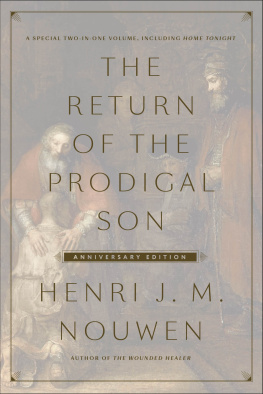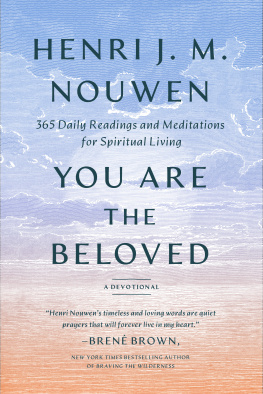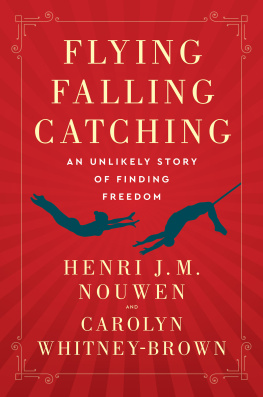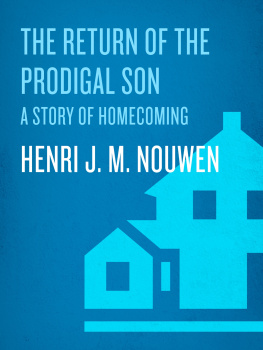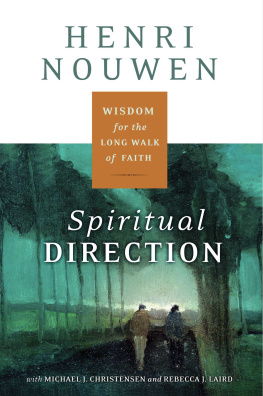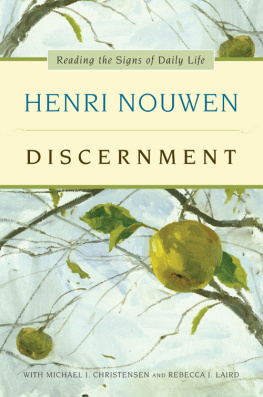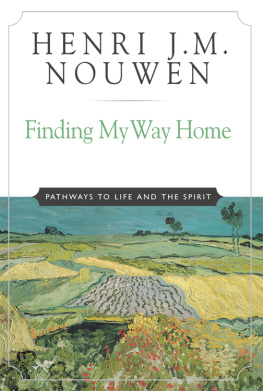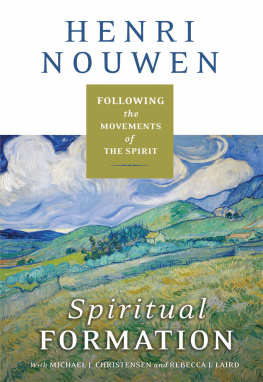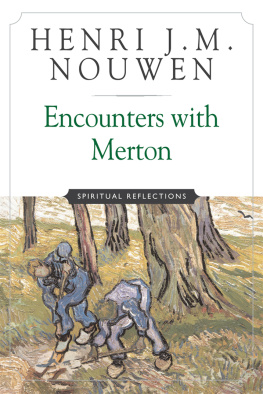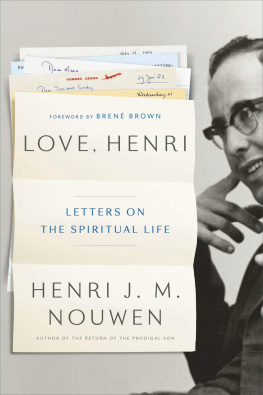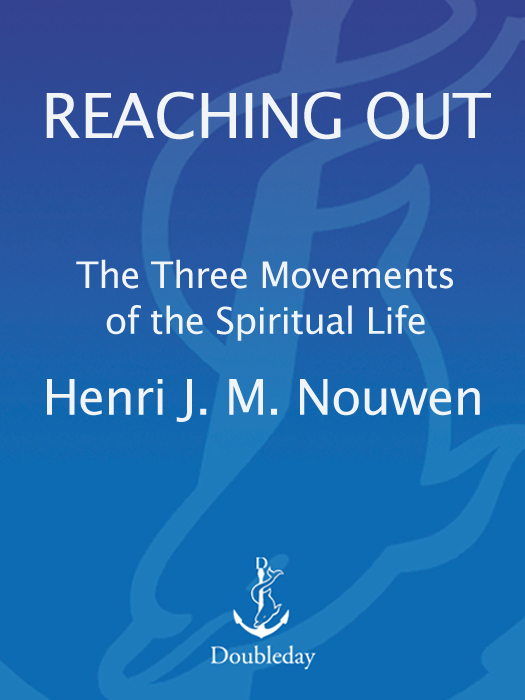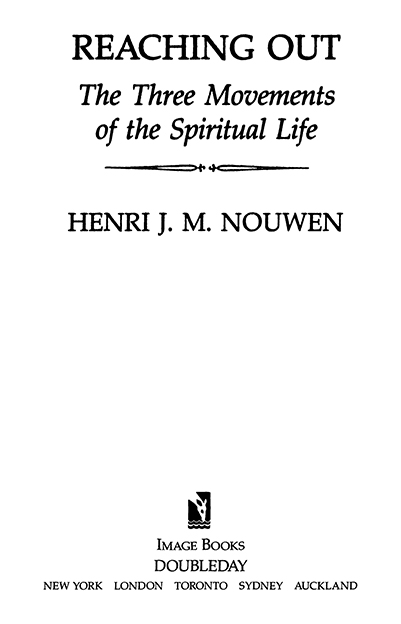Other Henri J. M. Nouwen titles from Doubleday
AGING
COMPASSION
CREATIVE MINISTRY
THE GENESEE DIARY
THE INNER VOICE OF LOVE
LIFESIGNS
THE RETURN OF THE PRODIGAL SON
THE ROAD TO DAYBREAK
THE WOUNDED HEALER
A N I MAGE B OOK
PUBLISHED BY DOUBLEDAY
a division of Bantam Doubleday Dell Publishing Group, Inc.
1540 Broadway, New York, New York 10036
I MAGE , D OUBLEDAY , and the portrayal of a deer drinking from a stream are trademarks of Doubleday, a division of Bantam Doubleday Dell Publishing Group, Inc.
Biblical excerpts from The Jerusalem Bible, copyright
1966 by Darton, Longman & Todd, Ltd., and Doubleday.
Used by permission of the publishers.
Excerpt from The Prophet by Kahlil Gibran reprinted with permission of the publisher, Alfred A. Knopf, Inc. Copyright 1923 by Kahlil Gibran; Renewal copyright 1951 by Administrators C.T.A. of Kahlil Gibran Estate, and Mary G. Gibran.
DRAWINGS BY MONA MARK
Library of Congress Cataloging-in-Publication Data
Nouwen, Henri J.M.
Reaching out
Complete and unabridged.
Bibliography: p.
1. Spiritual lifeCatholic authors. I.Title.
BX2350.2.N676 1986 248.482 86-2901
eISBN: 978-0-8041-5210-5
Copyright 1975 by Henri J. M. Nouwen
Illustrations Copyright 1986 by Doubleday, a division of
Bantam Doubleday Dell Publishing Group, Inc.
ALL RIGHTS RESERVED
v3.1
To my mother and father
ACKNOWLEDGMENTS
The first plans for this book developed during a short, lively seminar on Christian Spirituality at the Yale Divinity School. Its last pages were written two and a half years later during a long, quiet retreat at the Trappist Abbey of the Genesee. Although this book is closer to me than anything I have written and tries to articulate my most personal thoughts and feelings about being a Christian, it definitively is the book that needed and received the most help.
Without the sincere interest, the critical response and the original contributions of many students, I would never have been able to distinguish between what is personal and what is private, between what is universal and what is just me.
I am grateful to Gary Cash for his careful assistance in helping me integrate in this text many ideas that were expressed by students as a response to our first seminar. I also am very thankful to Ellie Drury for encouraging me to say what I had to say directly and straightforwardly, and to Mrs. James Angell for helping me say it in correct English.
I owe a special word of thanks to John J. Delaney, Dorothy Holman and John Eudes Bamberger for their invaluable editorial suggestions and to Pat Murray Kelly for her generous and skillful assistance in the typing and retyping of the manuscript.
To my mother and father, who created the space where I could hear and follow Gods call, I dedicate this book with love and affection.
Abbey of the Genesee
Piffard, New York
CONTENTS
REACHING OUT TO OUR INNERMOST SELF
The First Movement: From Loneliness to Solitude
REACHING OUT TO OUR FELLOW HUMAN BEINGS
The Second Movement: From Hostility to Hospitality
REACHING OUT TO OUR GOD
The Third Movement: From Illusion to Prayer
FOREWORD
This book is a response to the question: What does it mean to live a life in the Spirit of Jesus Christ? Therefore, it is a personal book, a book born out of struggles which in the first place were and still are my own. But during the years it became more and more clear that by deepening these struggles, by following them to their roots, I was touching a level where they could be shared. This book does not offer answers or solutions but is written in the conviction that the quest for an authentic Christian spirituality is worth the effort and the pain, since in the midst of this quest we can find signs offering hope, courage and confidence.
During the last few years I have read many studies about spirituality and the spiritual life; I have listened to many lectures, spoken with many spiritual guides and visited many religious communities. I have learned much, but the time has come to realize that neither parents nor teachers nor counselors can do much more than offer a free and friendly place where one has to discover his own lonely way. Maybe my own deep-rooted fear to be on my own and alone kept me going from person to person, book to book and school to school, anxiously avoiding the pain of accepting the responsibility for my own life. All that is quite possible, but more important is that the time seems to have come when I can no longer stand back with the remark, Some say others say, but have to respond to the question, But what do you say? (see Mark 8:27-30).
The question about the spiritual life is a very challenging question. It touches the core of life. It forces you to take nothing for grantedneither good nor evil, neither life nor death, neither human beings nor God. That is why this question, while intimately my own, is also the question that asks for so much guidance. That is why the decisions that are most personal ask for the greatest support. That is why, even after many years of education and formation, even after the good advice and counsel of many, I can still say with Dante, In the middle of the way of our life I find myself in a dark wood. This experience is frightful as well as exhilarating because it is the great experience of being alone, alone in the world, alone before God.
I wanted to write this book because it is my growing conviction that my life belongs to others just as much as it belongs to myself and that what is experienced as most unique often proves to be most solidly embedded in the common condition of being human.
One way to bring all that is written in the following pages together is to say that the spiritual life is a reaching out to our innermost self, to our fellow human beings and to our God. Reaching out indeed expresses best the mood and the intention of this book. In the midst of a turbulent, often chaotic, life we are called to reach out, with courageous honesty to our innermost self, with relentless care to our fellow human beings, and with increasing prayer to our God. To do that, however, we have to face and explore directly our inner restlessness, our mixed feelings toward others and our deep-seated suspicions about the absence of God.
For a long time I have been hesitant to write this book, which has such a personal background. How can I tell others about reaching out, while I find myself so often caught in my own passions and weaknesses? I found some consolation and encouragement in the words of one of the most stern ascetics, the seventh-century John of the Ladder, who lived for forty years a solitary life at Mount Sinai. In his chapter on discernment, step 26 of his spiritual ladder, he writes:
If some are still dominated by their former bad habits, and yet can teach by mere words, let them teach. For perhaps, being put to shame by their own words, they will eventually begin to practice what they teach.
These words seem sufficient to overcome my apprehensions and to make me free to describe the great human call to reach out to God and to those created in his image and likeness.


